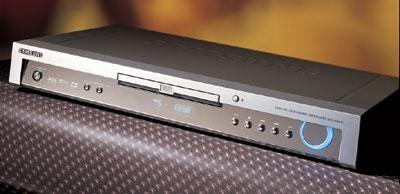Samsung DVD-HD931 Upconverting DVD Player

Along with the DVI output, the DVD-HD931 has what is by now the standard array of features, including playback for JPEG images and MP3 music files, a zoom control, and a virtual surround sound mode for its analog stereo output. The remote control is simple but functional, like previous Samsung DVD remotes, but smaller than those earlier models, with some of the buttons a little too closely spaced for confident operation by touch - at least by my small hands. Disc access and operation were noticeably slower than with other players, but not annoyingly so.
The front panel has the typical stripped-down array of disc-transport controls, along with a spectacularly lighted jog dial that, depending on the setting of the neighboring jog button, selects among the player's fast-scan speeds (up to 128x forward or reverse) or steps from frame to frame. (Unfortunately, the stepping works only in the forward direction, which makes precise cueing of something you just passed difficult.) The front panel is also the only place where you can switch the component-video output between interlaced and progressive-scan (the remote's Prog button is for programed playback) and access the controls for the DVI output.
| FAST FACTS |
| KEY FEATURES • Plays DVDs, CDs, and CD-ROMs containing JPEGs and MP3 music files • Upconverts DVD video to high-definition signal formats • Digital Visual Interface (DVI) output for direct connection to HDTVs or HDTV monitors OUTPUTS DVI, component video (switchable between interlaced and progressive-scan), composite/S-video; optical and coaxial digital audio DIMENSIONS 17 inches wide, 2 1/2 inches high, 9 1/2 inches deep WEIGHT 5 1/2 pounds PRICE $350 MANUFACTURER Samsung Electronics America, Dept. S&V, 105 Challenger Rd., Ridgefield Park, NJ 07660; www.samsungusa.com; 800-726-7864 |
So why bother? Because any high-def display has to do some type of conversion to play a standard DVD signal at the display's "native" screen resolution - say, 1,280 x 720 pixels. That resolution is bound to be different from the "native" resolution of DVD, so it's best to do the conversion in the player. Since the player "knows" a lot more about the signal - for example, the visual content of the preceding and following frames - it should do a better job than the upconversion processing in a high-def monitor. This assumes, of course, that the player's upconversion is up to snuff. If it is, images will look "cleaner" and have fewer visual artifacts like jagged diagonal edges and moiré effects.
But, as already noted, you need a TV with a DVI connector, which carries video signals in digital form. And if your TV has a fixed-pixel display - such as one using plasma, LCD, or DLP (Digital Light Processing) technology - a digital video output like the Samsung's is the best way to go because it eliminates a cycle of digital-to-analog-to-digital conversion that would otherwise occur between the player and the screen.
If your TV has a DVI input, however, make sure it conforms to the requirements of HDCP (High-bandwidth Digital Content Protection). The DVI output of the Samsung player feeds copy-protected signals even when it's playing nonprotected material. If your TV doesn't conform to HDCP, you get a screen full of "snow."
- Log in or register to post comments






























































